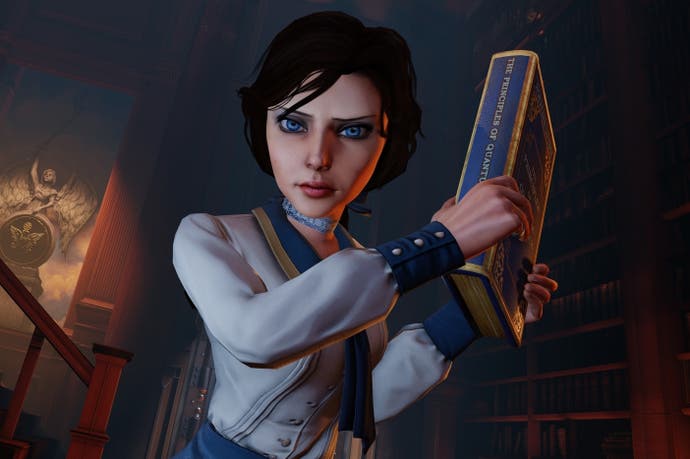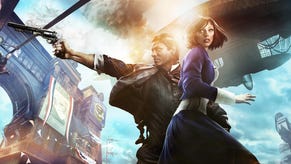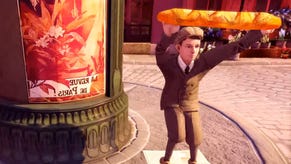Breathing life into BioShock Infinite
How Irrational's talented animators make all the difference - and why they hope you won't notice.
Shawn Robertson, the animation director of BioShock Infinite, is trying to remember something. "I'll double-check but I believe we have the ability to turn off the floating buildings, and that's so that people don't get seasick." Sorry, what? "Yeah, we've had a couple of people in the company who have. Don't forget this is a really big aesthetic thing - making you feel like you are in the sky - and when things float they don't stay in lockstep with each other, there's always this slightly undulating movement." In other words, welcome to the heavens - and watch out below.
Robertson could probably talk all day about exactly how his team made a floating city float - "It's not purely physical but it can interact with physics, you basically have these floating animations but they're not all on the same wavelength." His hands move up and down hypnotically. "So there's always a randomness. Multiply that by the 20-odd buildings you can see at any point and..." People get seasick?
We're racing ahead of ourselves here, but that's the kind of guy Robertson is - affable and possessed of an unmistakeable enthusiasm for his work. Animation is one of those things that's always difficult to talk about because, though we often think about it merely in terms of how individual characters move, what animators actually do is stitch together the entire world and then make it dance. It's an area where we know instinctively what works and what doesn't, but often fumble when trying to delineate exactly why.

With that in mind I ask Robertson if he feels animators don't get enough credit, an opening question that's surely a banker - but it turns out he's just too gosh darn nice to fall for it. "Well animation not getting much notice... I think it's one of those things where if it's done wrong everybody notices it, and if it's done right nobody notices it. I don't mean that necessarily in a bad way, it means you're allowing people to get involved in the world and sucked into what they're doing and have these characters really be believable."
So the highest praise, in this line of work, is not being seen? "Even when you're watching a top-notch Pixar film, after a while you don't really notice it's animation - you get involved in the story. The vast majority of the population will do that and not really notice the animation. The small minority of animators will be there picking it apart frame by frame," laughs Robertson, "but not normal people."
But movie animators don't have to worry about players - us and our irritating god complex, wanting to look at everything from every angle, and treating the camera like our own head. The camerawork on a game like Infinite is where you can see animation, while not quite responsible for function, is nevertheless responsible for whether it works or not. "The perspective is a mix of animation and system design," says Robertson. "The hardest thing to do is make it feel like you're not just floating along the ground. The minute you feel like a camera just moving along - which is essentially what you are, a cylinder with a camera on top - we've lost.
"The motion has to be introduced into a camera, and the trick there is if you put a camera on someone's head and just tell them to walk through a city, it's super jerky and hard to parse. So you have to animate a sense of movement without making your player sick, and every shooter has this issue - getting that weight so it feels like I'm taking steps and walking, that's the magic of animation, then once you've added sound effects that takes you pretty far along.
"But there's no one rule," Robertson concludes. "Like what should your head be doing when you land on a skyline? We want enough of a jostle that it feels like you made an impact, but not enough that you completely lose sight of what you're trying to do."
They've got the jostle dead-on, and it's part of a first-person perspective that has been quietly overhauled since BioShock. One of the things that most surprised me about Infinite is that, as a shooter, it's a marked improvement over its predecessor. It is familiar, of course, but my first headshot sends a policeman careening down some stairs, with his momentum responding perfectly to the impact of the bullet and terrain. Booker's pistol instantly feels like a much more meaty, weighty thing than anything from Rapture. What's changed?
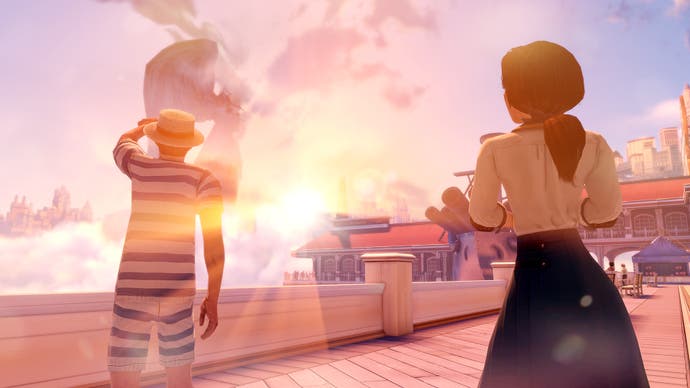
"We have new people like our systems designer that really push on what does a weapon feel like, how many frames of animation do we want for a kickback or a reload," says Robertson. "But basically I think the shooting feels better because we spent a lot more time focused on it, we actually had a team this time around of people whose job it was to think about user experience and user input - when I push this button, how long till an action happens, does it feel good, what's happening in the world, can I interact further?"
And what's the rule of thumb for animating combat - the shorter the better? "I had an animator whose primary job was working on hand animations and a lot of times [the system designer] would come down to him and say can we cut two frames off so it's a bit, sorry, punchier," laughs Robertson. "So he'd do that, we'd look at it from all sorts of angles and think about how it was different, whether it felt like a stronger punch. So you have these high-level issues and as you get closer and closer to ship that turns into arguing over single frames."
Then there's Elizabeth - the very core of what Infinite is trying to achieve. The character's face is slightly cartoony, exaggerated in certain respects, but nevertheless an instantly readable and convincing illusion, and I'm surprised when Robertson tells me that no mocap was involved with her facial expressions. "To be clear, there are different styles," says Robertson. "Some of the stuff other people have done with facial capture like LA Noire I think is brilliant, but when we were looking at what we needed... First we wanted Elizabeth to not have human proportions, even if you look at her face it's obvious we've given her larger eyes, a larger mouth... I mean, if you saw a real person walking around looking like her you'd think she was odd!
"The second reason is that when you capture facial data, it's like every bone has a keyframe on every frame, and from a technical standpoint it's a nightmare to work with if you want to push a specific expression or if you want to change an expression." So in layman's terms, you can't push her features around as much as easily? "Right. Hand-key really simplifies the process and lets us push her expressions just a little beyond what would maybe be comfortable for a normal human being. It also lets us iterate at that moment when we're animating, not three months ago when the mocap was shot, so we can roll with the punches on any changes or ideas that have come up for that scene as we're working on it."
Elizabeth is, as you'd expect, unrecognisable from what existed in early prototypes - the first of which was a mute that attracted attention by pulling your arm - and even her final form has gone through big changes. "The first Elizabeth we tried to do that pushed us towards hand-key was the Gibson girl we showed you, and she had a completely normal-looking face. Even in that early model she wouldn't have made it as a star character - she wasn't attractive enough, there were problems - but even there we could really see that in a game where you're moving around so much with a companion you want to elicit an emotional connection to, you really need to be able to see what she's thinking at all times."
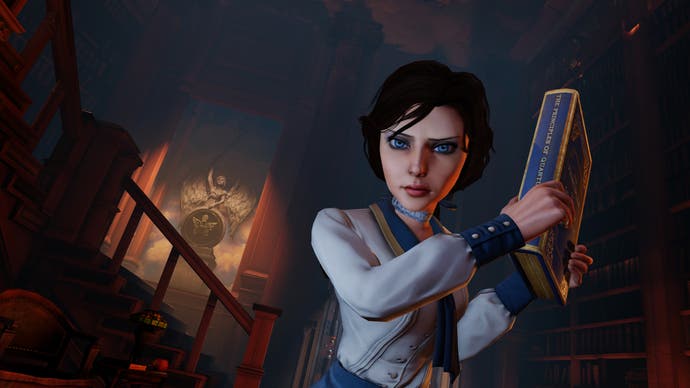
So Elizabeth's facial features, in terms of how they're exaggerated, are practical rather than aesthetic? "Exactly, we wanted to exaggerate her facial structure so that you could see her across the room and read the expression she has on her face. Even at 1080p your ability as a player to look at the screen and analyse what's going on - that is tough," says Robertson. "There are so many things - a gun, the UI, combat, things to pick up, you're moving constantly. So the resolution you're seeing all these things at is diminished somewhat just by the pure choice you have in what to look at. So we wanted to give Liz a nudge up, and that's why she's hyper-realistic."
It is impossible not to be impressed by Elizabeth's behaviour as you move around Infinite's opening stages; she's so good at noticing when you're interested in the environment, and making it more interesting, but when you're just moving through somewhere she'll do the same. "We call this the goalside behaviour, and on a place like the beach it's the most complicated thing," says Robertson. "There's a tonne of stuff for Liz to do there, but she kind of wants to stay on the side of you that represents where the game is saying to go - so if you take off in that direction it feels like she's slightly ahead of you."
"But if you turn around and decide you want to go elsewhere, she'll come with you and understand you're not quite interested in the goal yet and want to explore a bit. She'll find things to do. So if you pull her near the bucket with the rock on the beach, for example, she'll throw the rock. But once you start heading back towards the goal she'll drop the rock and start heading towards the door with you."
I ask how Robertson decides what Elizabeth's interested in, and whether Irrational has a target for the number of animations in each scene. "You start off thinking pretty simply, oh we're on the beach so maybe she's waiting by the water, maybe she's kicking up the water, this or that. Then you start getting specific once the beach is actually built and you see the props: it'd be great if she interacted with these boats over here, or that group. You never have a checklist of how many animations you're doing, you're reacting to the environment in a very slow-motion manner over the course of weeks and months. Then you get even more specific: the boat, for example, do you want her to look at it or point at it? Or with a railing does she lean on it or do something else?"
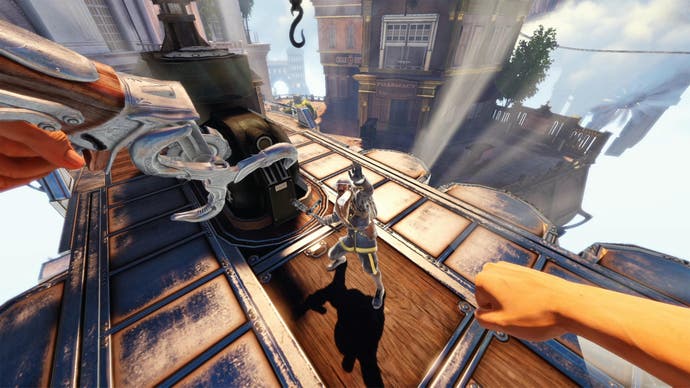
Which raises the question of how people look at things. I fear that I may be closing up on the most boring question I will ever ask, but Robertson handles it manfully - brace yourself.
How long should an NPC look at a boat?
"Now you're talking!" laughs Robertson. "These are the little things that make somebody human - how long do you look at things? How long can Elizabeth stare at one point before the illusion of her being normal breaks? If I'm staring too long at something, I've either had an aneurysm or fallen asleep, but if I'm doing this and then this [bobs his head around slightly] that's normal, but you then don't want that going on too long - so you start bracketing behaviour into what feels normal in a game world."
Is there a sweet spot for 'what feels normal' or do you just make it up as you go along? "You definitely have to know your audience with this stuff," says Robertson, somewhat opaquely. "You can get really low-level with this stuff and sometimes even internally someone will ask how we came up with a specific idea... you want the truth?" Hit me. "A lot of the time it's just 'Well, we tried it for this length of time and it kinda worked - so don't touch it!'"
Shawn Robertson's a lovely chap, clearly humble to a fault, and I don't quite believe him. He strikes me as one of those talented people that would rather deflect praise than encourage it, who puts things down to luck rather than skill, and who (I bet) hates people making a fuss over his birthday.
But who knows? Perhaps I just can't handle the truth.
